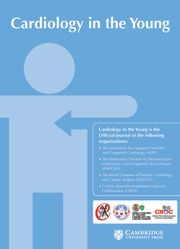No CrossRef data available.
Article contents
Two hundred and twenty-nine cases of bidirectional cavopulmonary anastomosis with and without antegrade pulmonary blood flow, a single-center experience
Published online by Cambridge University Press: 03 October 2024
Abstract
Bidirectional cavopulmonary anastomosis is palliative surgical procedure for stepwise adaptation of the ventricle by time-phased relief of blood volume from the single functional ventricle. There still exists a controversial question regarding maintaining additional antegrade pulmonary blood flow. We retrospectively reviewed the surgical cases of 261 patients who underwent bidirectional cavopulmonary anastomosis in our institution from 2012 to 2022 with special regard to antegrade pulmonary blood flow as our preferred strategy. The mean age at the time of surgery was 33.1 months (range 2.9–192 months), and the mean weight was – 7.6 kg (range 3.9–38 kg). Furthermore, we divided all the patients into two groups: in group 1 (n = 182) – patients who underwent bidirectional cavopulmonary anastomosis with antegrade pulmonary blood flow, and in group 2 (n = 47) – patients without antegrade pulmonary blood flow. The mean follow-up time was 56 months (range 24–120 months). Mortality rate was 4.8 % (n = 11) in the past 10 years. Statistical difference between groups was in the following positions: group 2 had less ICU stay (p < 0.000125) and hospital stay (p < 0.017110); group 1 had a longer duration of pleural effusion (p < 0.000003) and amount of drainage output (p < 0.007), also demonstrated higher oxygen saturation (p < 0.000264) and Glenn shunt pressure (p < 0.002) after the surgery; but there was no difference in oxygen saturation after 6, 12, and 24 months; mortality in both groups has no statistic difference. Considering our experience, we take a stand on the controlled to antegrade pulmonary blood flow strategy during bidirectional cavopulmonary anastomosis.
Keywords
- Type
- Original Article
- Information
- Copyright
- © The Author(s), 2024. Published by Cambridge University Press



